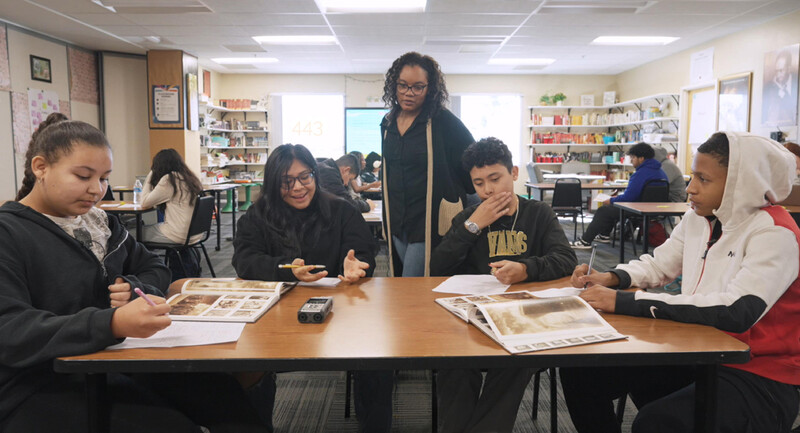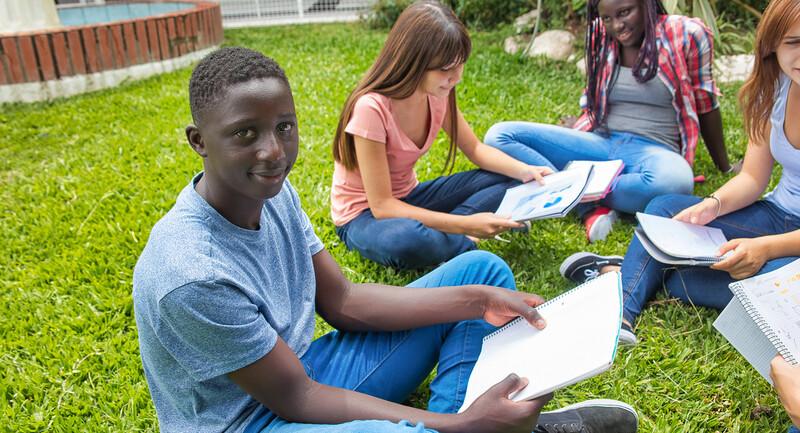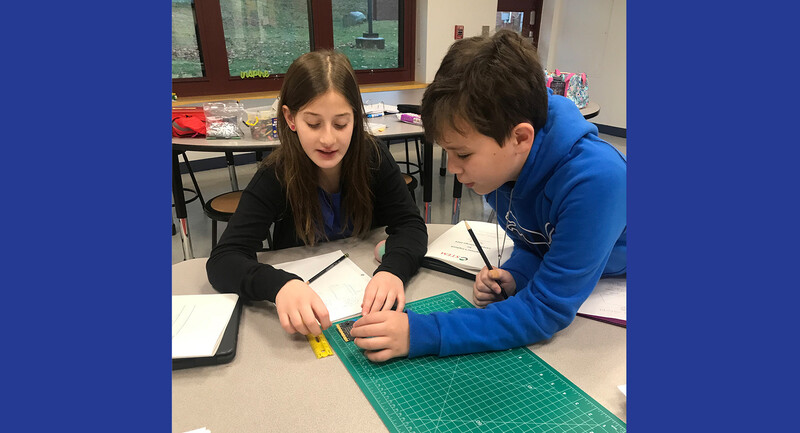Will today's call bring our students in contact with a fisherman in Alva, Florida? An amusement park owner in Chicago? A missionary in Mexico? Or, perhaps, an astronaut aboard an orbiting space shuttle? We'll soon see. Welcome to the amazing world of amateur radio, commonly called ham radio. In our lingo, CQ is calling any station, and AA0OF is my very own call sign, issued by the Federal Communications Commission.
During the past five years, students in our amateur radio club and class have sent and received Morse code messages, assembled and soldered circuit boards, designed and built antenna systems, and used computer programs to analyze radio communications problems. They have also searched for hidden transmitters (fox hunts), helped launch balloons resembling weather balloons with a transmitter as a payload, and assisted in our county storm-spotting program.
Thanks to a bond issue that residents passed, our middle school moved last year into a new state-of-the art building, featuring a media center with interactive television and labs for various technology programs. The building was designed to accommodate the influx of new students in our rapidly growing district eight miles west of Wichita. Our amateur radio club and class now have a specially built ham shack adjacent to the communications technology lab. The ham shack, with its outstanding antenna and tower system, enables students to operate amateur radio equipment and also to build and test electronic projects.
The Local Funding Circuit
We've come a long way since I first arrived at Andover in 1992. I launched the club as a relatively inexpensive way to incorporate technology into my social studies curriculum. Although the curriculum was good for what it covered, it failed to capture the essence of other cultures. I also found it difficult to integrate technology in an out-of-date classroom—one with two electrical outlets, only one of which worked.
Determined to make a positive difference in my students' lives, I turned to my father, Gary Hoffsommer W0TI, an inventor by trade and an enthusiastic amateur radio operator for more than 40 years. "Dad, surely there is some way I can bring the world to my classroom without spending major bucks." He suggested the obvious: "How about starting up a ham radio club?" My first thought was that I was not electronically smart enough. Little did I know that not only would I catch on, but my 50+ students—and their parents—would as well.
I began by meeting with a group of 10 students from a study hall to talk about exploring technology through an amateur radio club. We formed the club shortly thereafter, basing it in our classroom. Then we got some lucrative publicity. A reporter from a local newspaper wrote an article about us, leading a local ham radio operator, Raymond Metcalf W0QNX, to phone me with an idea. Why not establish a community-school partnership?
We took his advice, broadcasting our need for equipment. Many amateur radio operators—in Andover and around the country—responded. Before we knew it, they had donated not only radio equipment but also computers and test equipment, and they lent us other equipment until we could purchase our own. To obtain funds, I wrote several brief grant proposals.
Studying for the FCC
Even before we sought equipment, our immediate goal was to earn an FCC Novice Class amateur radio license. With Metcalf's guidance, my students and I studied electronic theory and Morse code, a small group of students and I using study hall time to prepare for the test. Working in teams, the students came up with creative strategies for remembering the Morse code and schematic diagrams, and we quickly learned the basic theory.
My students picked up the Morse code fairly easily; however, I struggled with the differences between a "dit" and a "dah." The students cheered me on: "Come on, Mrs. Hollenbeck, you can do it!" My students and I did do it, not only receiving our Novice Class licenses but soon having them upgraded to higher-class licenses.
The FCC allows individuals to transmit on the amateur radio frequencies if a licensed amateur radio operator—a control operator—is at the point of transmission (certain restrictions do apply). Because I was officially a control operator, the FCC allotted my students a wide range of frequencies and communication modes.
Old-Fashioned Tinkering
A major goal of our club and class is to encourage tinkering and experimentation. To spark student interest, the classroom windows display projects and ideas. One popular product of this philosophy is the astounding Tuna-Tin Transmitter, which students built with a handful of electronic components and, yes, a tuna fish can.
They discovered their transmitter worked when they used their prototype to converse in Morse code with a gentleman in New Mexico. His signal report indicated a slight hum and ripple but was perfectly readable. After making this contact, the students cheered. Talking from Kansas to New Mexico was quite a feat, considering the transmitter's components and its use of less than 5 watts of electricity.
Using our one working electrical outlet (with assorted power supplies, power strips, and extension cords), students made hundreds of contacts that linked high-frequency radios, computers, and antennas they had constructed. They chatted daily with a Florida fisherman; and conversed with an Illinois amusement park owner who was traveling from coast to coast and with a man sailing to the Bahamas.
Using a computer satellite tracking program, their knowledge of Andover's exact latitude and longitude—and ingenuity—students determined the exact time (Universal Time Coordinate) that the Russian space lab Mir was directly overhead. When they used our computer to radio to the space station computer, they got a response: "Hello from Mir Space Station Crew #20 !!! Yuriy and Thomas and Sergey."
Before embarking on the ham radio enterprise I had applied for and received a Shuttle Amateur Radio Experiment contact, part of a program that NASA set up to gather data on the use of amateur radio for communication between earth and orbiting shuttles. NASA gives priority to school contacts, and on September 22, 1996, we made the ultimate contact. Jay Apt N5QWL, a veteran of four shuttle missions and an avid ham radio operator, talked to the students during his STS-79 mission. In the allotted 10 minutes, the students asked more than 20 questions. In the spring, Apt led our Introduction to Amateur Radio class, discussing radio wave propagation, then fielded questions at an all-school assembly.
One of the new highlights of our amateur radio program is Slow-Scan television, which permits operators to receive and transmit color pictures. Students particularly enjoy their contacts with a Mexican missionary who is a ham radio operator. He shares his pictures and knowledge of Mexico's people and land, and the students in turn transmit pictures of our classroom projects and themselves.
From One Outlet to Many
It's hard to believe that we began this enterprise with a box of spare electronic parts and one electrical outlet. (For the record, we now have several outlets in our room.) We've shown that school technology does not have to be excessively expensive. By fostering a partnership with local businesses and community members, we have ensured our students many learning opportunities.
The local ham radio community has continued to offer support, providing the expertise to keep the antenna system and radio equipment operating well. On Tuesday evenings, students host a popular amateur radio "net"—a program with a game-show format where amateur radio operators of all ages attempt to answer electronic theory questions. To build further community support, I have held Saturday student-parent classes, an enjoyable way to introduce new communication technologies in a team learning atmosphere.
We also continue to receive considerable newspaper and television coverage. In addition, my students and I present many communication technology demonstrations at meetings of the school board, local amateur radio clubs, and Kiwanis. We even take a trip every other year to the International Ham"vention" in Dayton, Ohio, where our students showcase their operating and technical skills. Our excitement over our new communication technology has piqued the interest of several other district teachers. They, too, have taken the time to study for an amateur radio license.
The best part of amateur radio is that everyone can find some activities they enjoy. Many students like operating a basic form of communication—Morse code, while others enjoy contacting fellow hams around the world by bouncing signals off the moon. Not all our projects work the first time, and some never work, but the students' determination remains constant.
We will continue to explore new communication modes and look for special electronic projects to build. And my students and I will no doubt continue to amaze ourselves. As Matthew, one of my budding amateur radio enthusiasts says, "Gee, Mrs. Hollenbeck, we have friends all over the world!"







